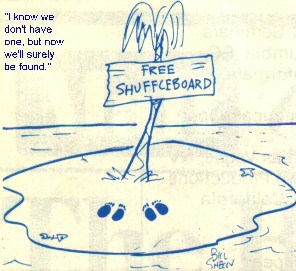THE HISTORY OF
SHUFFLEBOARD
Excerpt/Reprint from
TAVERN SPORTS International
JUNE/JULY 1989 Issue, page 4
By Joe Falvey

All sports have unique
histories, but few, if any, have been as affected by political
and international events as shuffleboard.
Now, to research shuffleboard you
don't exactly go to your 'Funk & Wagnalls' and find
everything neatly compiled. So, in lieu of that, you do the next
best thing -- you call Sol Lipkin. Sol's name may not come up
when people are talking about the great players of the game, but
if he isn't "the father of modern shuffleboard" in
this country, then no one is! No one has -- or ever will -- love
the game more than Sol. He's played, promoted and been involved
in the manufacturing of shuffleboard for over 60 years. Even
today (at age 83) he is still actively involved with the
American Shuffleboard Co., in Union City, N.J.
True shuffleboard -- first called
shoveboard and then, inexplicably, shovelboard -- seems to have
orginated in England, where there is a record of its being
played in 1532, and in its earliest form consisted of shoving
coins across a polished tabletop as a pasttime for royalty. But
the game became so popular with the masses that people stopped
going to work, causing it to be banned. Shuffleboard first came
to the United States around the time of the Civil War and
enjoyed tremendous growth during the late 1800s and early 1900s.
In fact, the great hotels in Atlantic City and all the
first-class hotels in the East had five or six tables right
through the Roaring '20s.
Then came Prohibition. Speakeasys
didn't need or want games of skill. They had been assured of all
they needed to be successful in their businesses by the U.S.
Congress. It was during this eight- to 10-year period that
shuffleboard began to decline. Following the repeal of
Prohibition, pockets of shuffleboard players began to reappear,
largely on the East Coast. And the tavern industry began to
change. All the bars before Prohibition had backrooms with small
restaurants. But on the heels of the Great Depression, people
didn't have the money to go out to eat. Gradually, some
backrooms were converted to shuffleboard areas.
"It brought the people out.
We were selling boards at that time for $149," said Sol,
who also became a promoter. "We would set up a match
(sometimes played to 75 points) and pack the place. "People
would stay all day long." Leagues began to form and
shuffleboard was on the move again.
With World War II, men from all
across the country were routed through New York and the
Northeast on their way to Europe. As a result, shuffleboard went
national after the war, with soldiers bringing a love of the
game back home with them. Over the next few years more than 100
companies started manufacturing boards because of the demand.
The original boards were 32 feet long, but were shortened to 28
and then to 22 feet because how they were packed and shipped
nationally. The weights went from heavy brass to the streamlined
stainless steel of today. Sand, used to speed the boards,
evolved into fine corn and silicone waxes. Regional tournaments
began to take place everywhere and the first national event was
held at the Armory in Springfield, Ill., in 1948, with 574
taverns represented by l0-man teams. By the mid-1950s,
shuffleboard had jumped into the foreground. They were on
military bases, in fraternal clubs, rehabilitation hospitals,
youth clubs, town centers, seniors centers and taverns
everywhere.
But despite all this popularity,
the shuffleboard movement lacked a couple of key ingredients.
Not having consistent rules or amateur events created a lot of
in-fighting among the leaders and manufacturers. And problems
couldn't have come at a more inopportune time. It was the dawn
of the electronic game age. However, a very strong grassroots
group of players kept the sport alive. As Sol Lipkin says:
"It's the game that makes shuffleboard great." That
has remained constant.
Shuffleboard has made a strong,
steady climb back through this decade. This time it appears
things will be different. Now, there are national rules and
sanctioning; media exposure; and a policy board of professional
players. Interested sponsors.
Shuffleboard finally has come
full circle. A 100-percent increase in participation. New
manufacturers. More than one million shuffleboards are in use.
New leagues are springing up everywhere. Despite a long and
sometimes bumpy history, the game has endured. Fifty or 100
years from now the "new history" will show that in the
late 1980s and '90s the sport used lessons of the past and
wisdom of people like Sol Lipkin to keep it growing for many,
many years to come."
(Reprint, Tavern
Sports, June/July 1989)